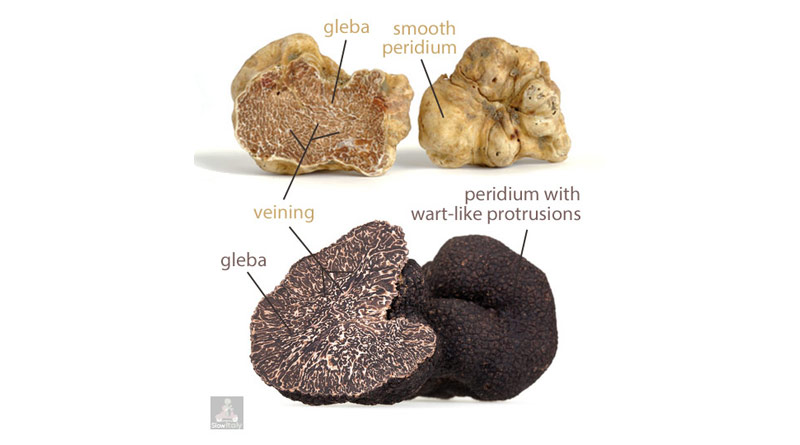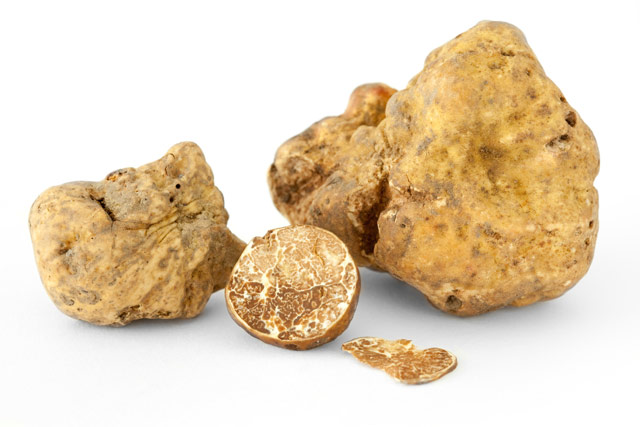
Myth 1. Black and white truffles differ in color and flavor, but are consumed in much the same way
Not at all. Black truffles act as an ingredient while white truffles are almost exclusively used as a condiment. This means that black truffles are best added during the cooking process (though preferably towards the end of it), as their flavor is intensified in oil or butter and with a little heat.
The white truffle’s, strong, pleasant smell is more intense than that of the black truffle. However, unlike black truffles, which are more defined by their taste than their smell, white truffles have more aroma than taste, so they are very sensitive to heat and lose their aroma when cooked. So, they are almost exclusively consumed raw, as a precious finishing touch to top a fairly neutral dish.
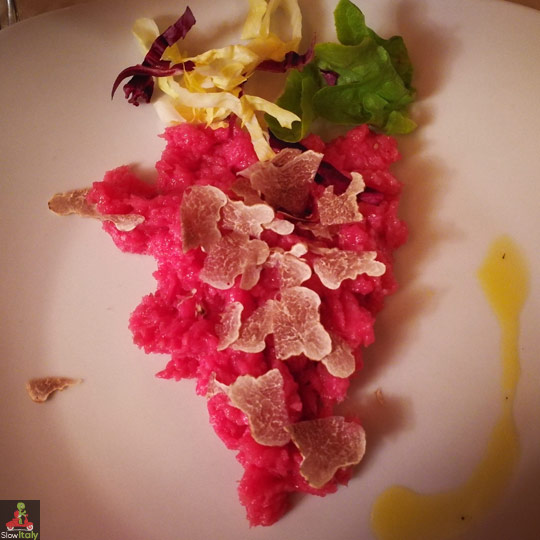
Like the Norcia or Périgord black truffles, Italian white truffles are very sought after and, as a consequence, very expensive. Because of their incredible aroma, white truffles are considered even more refined than black truffles and are also more expensive (up to five times more, depending on the quality).
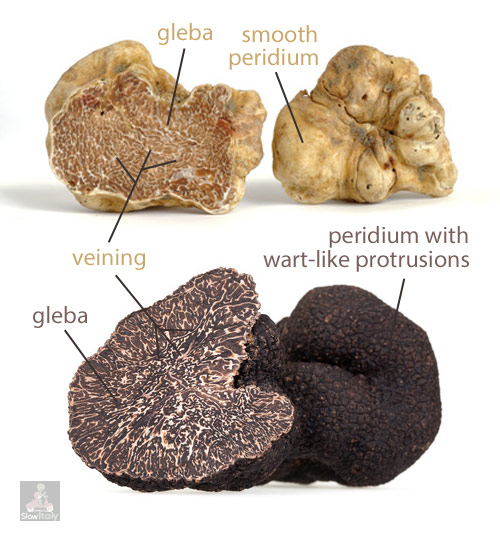
Myth 2. The prized white truffle (Tuber magnatum) comes exclusively from the area around Alba, hence why it is called Alba White Truffle
No…Despite their name, Alba truffles do not necessarily come from Alba in the Italian Piedmont.
Actually, the same quality of prized white truffle (Tuber magnatum), tartufo bianco pregiato in Italian, can be found in other areas of Italy, including other areas in Piedmont, but also in other truffle-producing regions such as the Marche, Molise, Tuscany and Emilia Romagna.
The official and historic denomination of the prized white truffle is, in fact, Alba White Truffle and Acqualagna White Truffle (after the comune in the Province of Pesaro e Urbino in the Marche region).
White truffels are also harvested in Lombardy, Liguria (Ligurian Langhe and Alta Val Bormida), Umbria, Lazio, Abruzzo (Val di Sangro), some valleys of Basilicata and along the coastal pinewoods in Calabria. However, it is true that the area of the Langhe, Turin and Montferrato hills in Piedmont seems particularly suitable for white truffles.
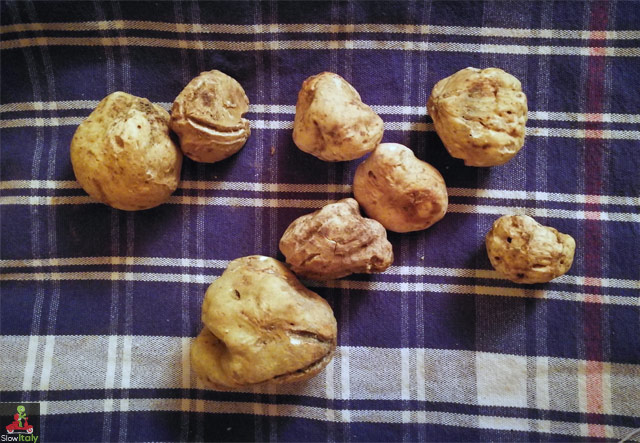
The International Alba White Truffle Fair (Fiera internazionale del Tartufo Bianco d’Alba) is also the oldest white truffle market and most important white truffle event in Italy, and also the only one with international scope and fame (for a list of national and local white truffle fairs in Italy, see Fact 10 below).
Myth 3. White truffles are used grated or ground to flavor dishes
No, unlike black truffles, which are preferably grated or ground, white truffles should always be sliced with a special truffle slicer.
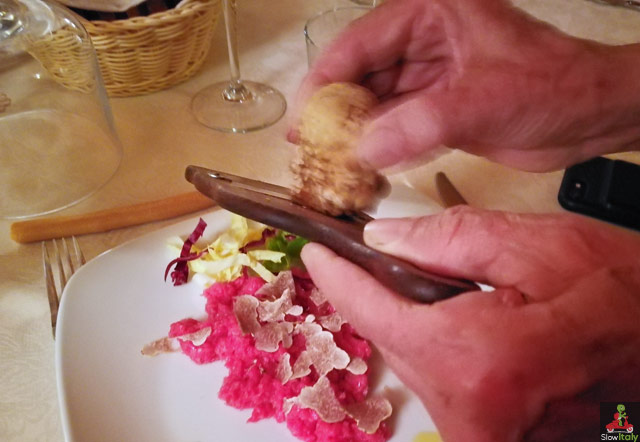
Myth 4. White truffles can be stored in oil
By no means. White truffles will ferment in oil. Also, as their main gastronomic properties lie in their aroma, white truffles will soon lose their value if not stored correctly or not consumed within the proper time.
What is generally designated as “taste” is basically a combination of different sensations, not only perceived by our taste buds, but also “shaped” by our sense of smell and by the food’s texture, any method of preserving white truffles that will alter their aroma or their texture, or both, will completely kill their flavor.
Myth 5. White truffles are best stored in rice
The reason why (black) truffles are sometimes stored in rice is because the rice will absorb not only moisture, but also the black truffle’s aroma (leaving the taste intact), so that the rice can subsequently form a base for risotto al tartufo nero.
Because white truffles’ gastronomic value is entirely due to their aroma (instead of their taste), storing them in a medium that will absorb their aroma would make no sense. Also, because of their smooth surface, white truffles lose their humidity more quickly than black truffles, especially if they are placed in a medium that absorbs humidity, which causes a weight-loss. Therefore storing them in rice is not recommended, or if so, they should at least be wrapped in a paper towel, to prevent them from being in direct contact with the rice.
The best way to store white truffles is wrapped in a paper towel inside a closed plastic or glass jar, preferably in the vegetable compartment of the fridge where the temperature is not too cold. The paper towel should be changed every day to avoid damp from building up within the jar. The precious aroma will remain present in the jar for a while even after consumption of the white truffle. So, after consumption would be the right moment to add rice or a few fresh eggs in the empty jar to absorb what is left of the precious fragrance.
Myth 6. If stored correctly white truffles can be kept for months
Absolutely not, white truffles should be consumed as fresh as possible, or within maximum 7 days after buying them.
Myth 7. White truffles should be peeled to remove the earth, dust and debris
Not ever. White truffles are never peeled. Just brushed with a small delicate brush or wiped with a damp cloth to remove dirt. A pointed knife can be used to remove dirt in the identations.
Myth 8. White truffles are hunted with pigs
Not in Italy. It is true that sows have a natural inclination to dig up truffles, as the aroma of ripe truffles (especially the black ones) is similar to the hormones secreted by the boar. However, the practice of using pigs to hunt for truffles slowly faded out after WWII in favor of hunting with truffle dogs, and has been prohibited in Italy for all truffle hunting since 1985. The main reason is that pigs cause a lot of damage on the vegetative part of the truffle when they dig, which may impact future truffle yields. Pigs are also much less trainable and controllable (even if they are said to have an even better nose for truffles than dogs), and so it is not uncommon for them to devour part of the harvest.
In Italy trufflers use specially trained dogs. There is even an Italian dog breed, the Lagotto Romagnolo (Romagna Water Dog), a water retriever of ancient lineage that has been specifically bred for its retrieving qualities and excellent nose in association with truffle hunting. They are small to medium-sized dogs, with a curly coat and floppy ears. On top of their truffle hunting capabilities they are also considered a hypoallergenic breed.
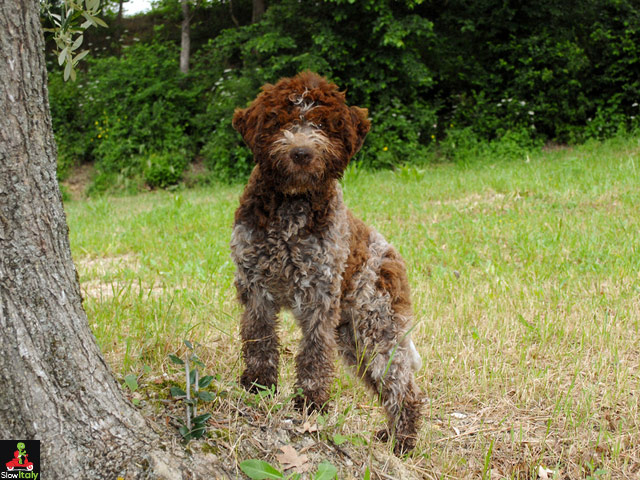
Myth 9. White truffles are as expensive as gold
Even though they count among the most precious foods, fortunately they are not as expensive as gold. At the time of writing the official price for 1 gram of gold is at 35 euro while 1 gram of white truffle cost between 3.5 and 5 euro (market price in Italy). The white truffle’s weekly rate per hectogram (100 g) can be checked on the following page http://www.tuber.it/it/borsino-del-tartufo.php
Myth 10. The white truffle season ends with the closing of the Alba Truffle Fair
Nothing could be further from the truth. Actually, when the Alba Fair closes the truffle season is at its peak! Prices go down almost overnight, and the most interesting period starts. That is, except during the difficult years, when the quantity of truffles is very low. Actually, many national and local white truffle fairs start when the Alba White Truffle Fair closes (see Fact 10.)
The Alba truffle fair usually ends on the last Sunday of November while the truffle season lasts until the end of December. So, some say that the right time to go to Alba is after November 15!
Also, the warmer the outside temperature the shorter white truffles last, so further into the season white truffles bought on the market will last a little longer.
Fact 1. The prized white truffle is not exactly white
The Alba white truffle comes in various shades of color, ranging from white with pink veining to amber/grey with darker veining, depending on the host tree it lives off. White truffles which developed on oaks will have a darker reddish gleba (flesh), while truffles growing on poplars will have a yellowish gleba, and those growing on willows will be almost white. Their aroma will also differ a little according to the host tree.
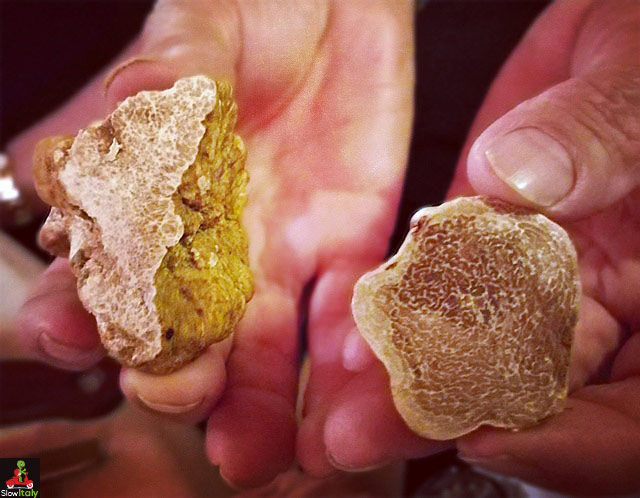
Fact 2. Truffels are not tubers
Unlike their botanical name suggests (Tuber genus), truffles are not tubers, but wild, underground fungi (mushrooms) that grow symbiotically with the roots of their host trees. White truffles grow on different species of oaks and poplars, willows, hazels and linden trees. They can reach 12cm in diameter and weigh up to 500g or more, though are usually between 150 and 400g.
Fact 3. Artificial cultivation of white truffles is not possible yet
While farming of some truffle varieties (Tuber melanosporum and some other minor varieties) has been successfully experimented, white truffle cultivation is still in an experimental phase with inconclusive results. Truffle farming is extremely regulated by Italian law, which draws a clear distinction between “controlled truffle grounds” (natural, but improved) and “cultivated truffle grounds” (started from scratch).
Truffles not only need a particular soil and climate combination, and specific host trees with whom they grow symbiotically, but they also require other plants, known as comari (“co-mothers” or stepmothers; the word is similar in meaning to the Scottish word cummer). These “co-mothering” plants do not join in the symbiosis, but are nevertheless vital to the truffle’s occurrence and development. As they require the same environment as the truffle to thrive, these comari also act as indicators or pointers for the presence of specific truffles in a certain area. So, each truffle variety requires not only a special type of soil and specific host trees, but also the presence of specific other plants, which explains the complexity of growing them artificially.
Another aspect is time, as it can take up between five to ten years from the inoculation of a seedbed plant to the first mature truffle.
Fact 4. Available only a few months a year
White truffles are harvested from September to the end of December / end of January (depending of the region)
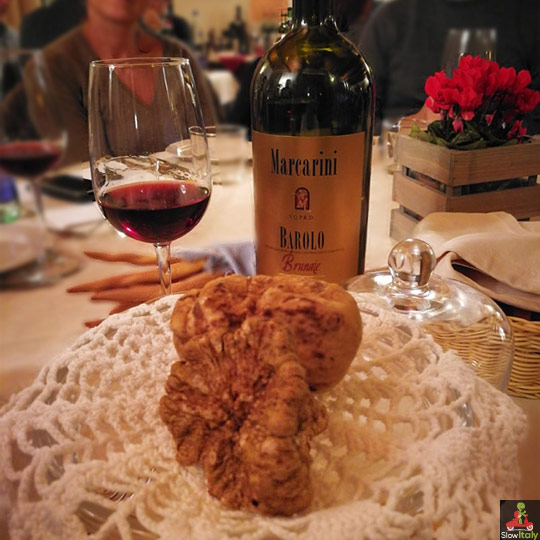
Fact 5. Some great ways to consume white truffles
White truffles pair well with rather neutral foods that will not overpower the aroma of the white truffle such as:
– veal or beef tartare, cut by knife rather than ground, just with a bit of oil and garlic
– tajarin (the local Piedmontese egg pasta) seasoned with butter
– scrambled eggs, seasoned with salt and pepper and topped with white truffle
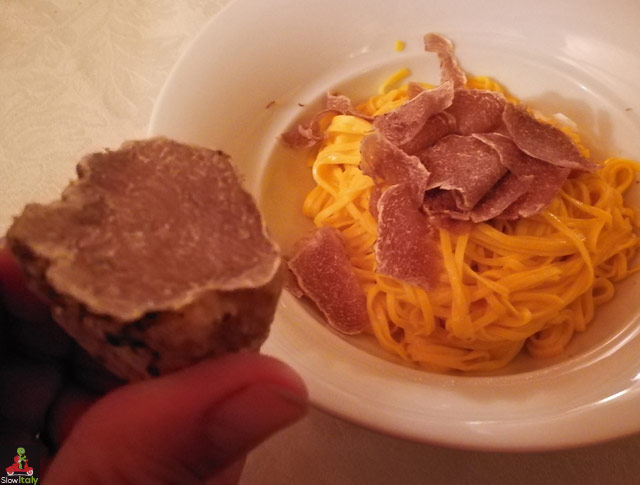
Less neutral in taste, but yet a fairly common dish that is paired with white truffle is the Piedmontese fondue: a regional specialty made of fontina cheese, milk, butter and egg yolks mixed into a fondue-like mixture topped with sliced white truffle.
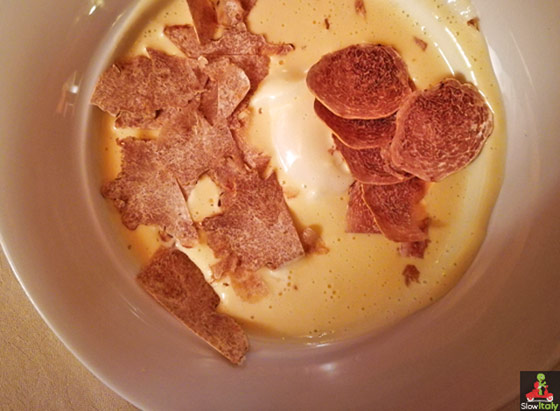
Fact 6. Recommended quantity
The recommended quantity is 10 grams per dish, but if the white truffle is of excellent quality and perfectly ripe, 7 to 8 grams may suffice.
Fact 7. The truffle harvest is extremely regulated.
Prospective truffle hunters must pass a test and obtain a permit proving their ability and knowledge. Only those who wish to harvest truffles on their own land are exempt from this regulation.
The hunt must be done with the aid of a truffle dog that has been especially trained for that purpose.
Digging must be done with a special truffle tool and must be limited to the spot indicated by the dog’s scratching. Apart from these provisions, the truffle hunt is open to all on uncultivated land or in woods.
Fact 8.White truffle preserving
As we already stated in the list of myths, white truffles are more perishable than black truffles and as it is mainly their aroma that makes their uniqueness, none of the preserving methods (oil, saline solution, freezing) that may work (to a varying degree) for black truffles will work for white truffles. They will either ferment or change texture, and lose their aroma alltogether.
Fact 9. The prized white truffle is not the only white truffle variety
Apart from the prized white truffle there is also another white truffle, namely the bianchetto truffle (Tuber borchii vittadini or Tuber albidum pico).
The bianchetto truffle’s outer appearance can be confusingly similar to that of the authentic white truffle, although they are generally smaller in size, reason why they are sometimes passed off as smaller prized white truffles. However, their veining is different, wider, almost patch-like, and scarcer. The gleba (flesh) is originally white but can turn reddish brown when the truffle is ripe. They have a very distinct (but not so intense) aroma; rather sharp, with an unmistakable garlic-like touch, but not as rounded as that of the the prized white truffle.
Bianchetto truffles can be found throughout the year, but with greater frequency from mid January to the end of April, hence why they are also called the white spring truffle or marzuolo (March truffle).
There is also another white truffle, the Tartufo dei Porci (Choiromyces meandriformis), but this one is not edible.
Fact 10. The Alba Truffle Fair is not the only white truffle fair in Italy
The Alba Truffle Fair is the most famous because it is the only international truffle fair in Italy, but there are a dozen other fairs at national and local level, such as:
– Fiera Nazionale del Tartufo Bianco Pregiato, Sant’Agata Feltria (province of Rimini, Emilia Romagna), October
– Fiera Nazionale del Tartufo di Aqualagna (province of Pesaro and Urbino, Marche) in October and November
– the Turinese Hills White Truffle Fair in Rivalba (province of Turin, Piedmont)
– San Miniato White Truffle Fair (in the lower Arno Valley, Tuscany), last three weekends of November
– Pergola White Truffle fair (province of Pesaro and Urbino, Marche)
– Sant’Angelo in Vado (province of Pesaro and Urbino, Marche)
– San Pietro Avellana Fiera del Tartufo Bianco (Molise), November
– Fiera del Tartufo Bianco, Frosolone (Molise), December
– Molise White Truffle Fair Isernia (province of Isernia, Molise), beginning of December
– Truffle Fair in Moncalvo (Piedmont), last week of October
– Tartufesta, Sasso Marconi (Emilia Romagna), end of October and beginning of November
– Sagra del Tartufo Bianco Pregiato di Savigno (Emilia Romagna), three first weekends of November
– Truffle market (Mostra Mercato del Tartufo Bianco) in San Giovanni d’Asso (South east of Siena, Tuscany) second and third weekends of November

